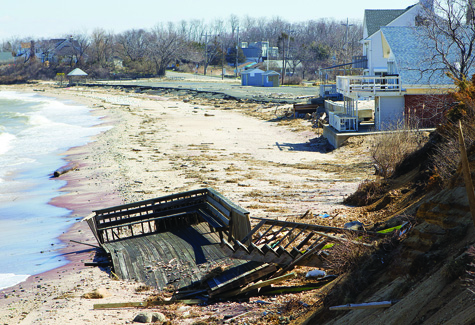Property owners’ group cries foul over joint approach to erosion

As the storm-driven Sound continues to batter Southold’s northern shore, neighbors are hip-deep in a war of words that began with a plea to the Town Board last week.
Southold Town’s Conservation Advisory Council was late to the debate when it issued a series of recommendations to the Town Board two weeks ago for a coordinated effort to stop erosion along the Hashamomuck Cove section of Southold. Homeowners there are paying a heavy price for emergency shoreline protection, and each storm brings the water closer to the narrow stretch of County Road 48 between the Sound and Hashamomuck Pond.
Southold Town, Suffolk County, New York State, the Army Corps of Engineers and the Federal Emergency Management Agency had been studying the erosion problems at Hashamomuck Cove for decades before the post-Christmas nor’easter last year wiped out much of the shoreline there, though they have not taken any action on the studies.
Representatives of all those agencies attended a town forum on the issue in early March. The town, county and federal government have agreed to participate in a study of potential erosion fixes at the site and claim the state has dragged its feet on financing its portion of that study. Meanwhile, homeowners have barraged the Southold Town Trustees with requests for permits to protect the shoreline in front of their houses.
That’s where the CAC comes in. Members of the citizen group, which acts as advisers to the Trustees, are concerned that what they consider a piecemeal approach taken by individual property owners may cause more harm to the shoreline. Their fear is that when wealthy neighbors make structural improvements along the shore and less-affluent residents cannot, the erosion will continue regardless of the investment made on some properties.
CAC Chairman Peter Young and members Doug Hardy and Jack McGreevy asked the Town Board last week to convene a conference to consider an overall shoreline protection design, what laws may need to be changed to accomplish that and identify funding sources such as grants or creating a special funding district.
Although the Town Board voiced skepticism on the possibility of coordinating all the involved agencies, one member of the audience thought the CAC’s suggestions sounded like an attack on the property rights of Hashamomuck Cove homeowners.
John Betsch, who chairs the waterfront homeowners’ group Southold Voice, said in an article that appeared the next day on the organization’s website that waterfront property owners were being targeted by the CAC.
“On the surface, the concept of universal cooperation to address these issues appears to be a reasonable thought,” he wrote. “However, when terms and statements like special use districts, build/no build areas, needed regulatory changes, hard setbacks and the funding of engineering studies with the costs appropriated to homeowners according to ‘at risk’ situations are bantered about, there is concern.”
The CAC members, however, seemed more concerned last Tuesday that Mother Nature may not allow either the government or the property owners to choose the shoreline’s future.
“Let’s take a look at this from a broader perspective,” Mr. Young told the board. “There are some changes in terms of the physics out there that are changing the dynamics of what’s happening along the shoreline. It will probably get worse.”
Mr. Hardy, a retired marine scientist, said that the best news he had for the board was that he doubted the sea level would rise more than seven feet by the year 2100. He said that government agencies are now designing coastal structures for the eventuality that the sea level will be 2.5 feet above the current level by 2080.
“When you elevate the sea level 2.5 feet, then when you have storm surges, the damage is going to be unbelievable,” he said. “The town should now enforce the waterfront with the concept that sea level is not stable. It is going to rise. Waterfront property owners must have the expectation of what their real estate investment is. They’re not going to be able to stop it.”
Mr. Betsch said in an interview Tuesday that he believed that talk of sea level rise did little to help the immediate problems with the shoreline.
“We’d welcome help, but we would not classify that as help,” he said. “I can produce as many studies that say the [rising sea level] models are incorrect. We need verifiable facts.”
Mr. Betsch said that he was primarily concerned with the CAC members’ testimony to the board, not the memo. He said that he believed the idea that the cost of work to stabilize the shoreline would be covered by stakeholders puts homeowners in the position of possibly paying more than they already do in taxes.
“In theory, I think it’s a fantastic idea,” he said. “But if you ever try to get three kids to play together, it’s impossible. How do you get all the agencies to come up with one plan?”
Peter Young could not be reached for comment this week, but his response to the article on Southold Voice’s website highlights his concerns.
“It is a real stretch to construe the intent of the CAC memorandum as ‘targeting waterfront property owners,’ ” he wrote. “In your website review, your caption suggests a pre-ordained Pavlovian reflexive response by your organization to anything proposed to solve the problem. It is unfortunate because you only present a disservice to your constituency. Why not engage in substantive dialog instead of circling the wagons?”








